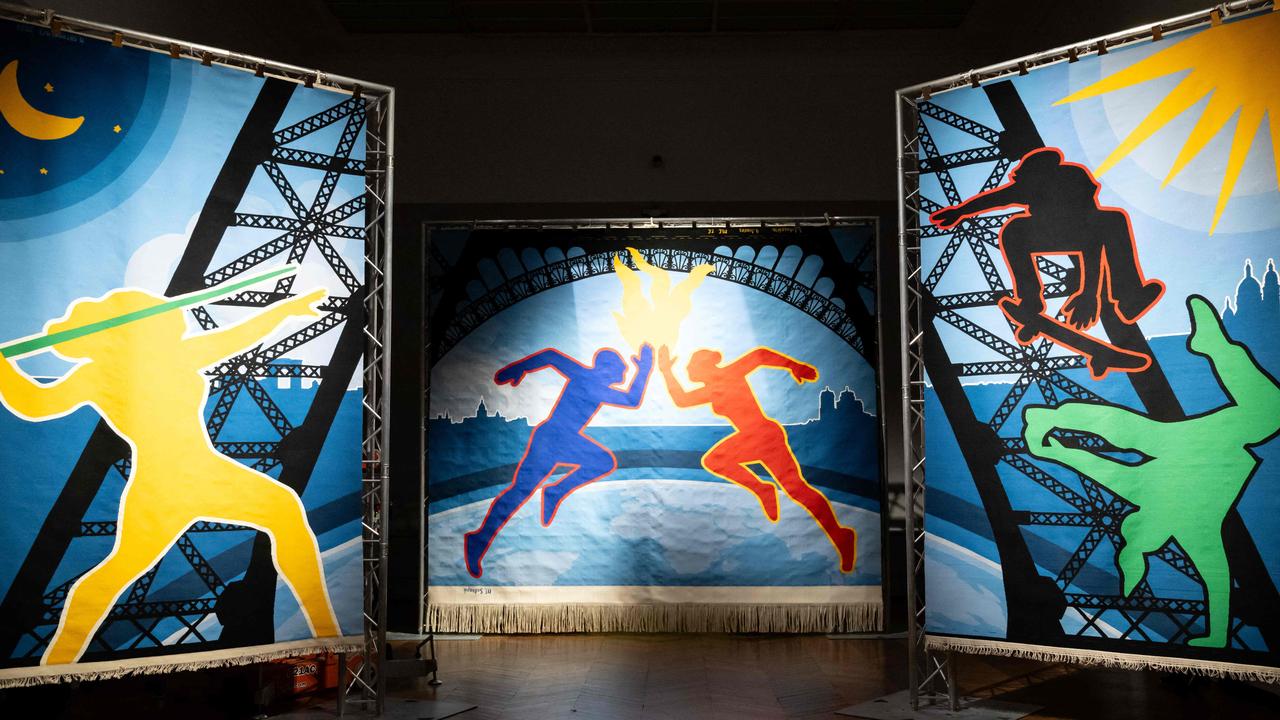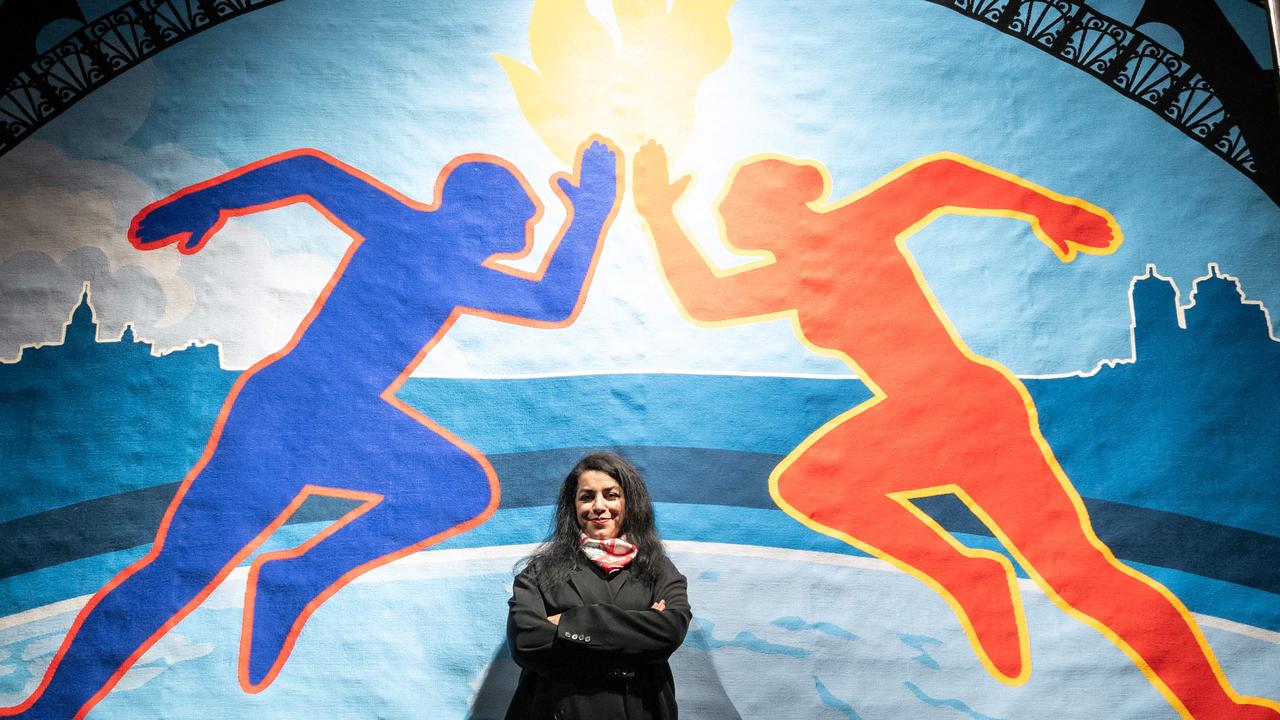Olympic-inspired tapestry art unveiled in Paris to celebrate 2024 Games
As a stunning Olympics tapestry is unveiled ahead of the Paris Games, we take a look at the history of this ancient art and where you'll find some of Australia's most magnificent examples

READING LEVEL: GREEN
A tapestry* depicting Olympic athletes competing around the Eiffel Tower, and designed by French-Iranian artist Marjane Satrapi, was unveiled in Paris in the lead up to the 2024 Games.
The nine metres long triptych*, which is composed of wool and weighs 60kg, took three years to weave.
It features the silhouette* of athletes in bright colours, poised to race or mid-competition, against the base of the Eiffel Tower and Paris skyline.

The artist said she thought she was being pranked when asked to design the piece.
“When I got the call, I thought it was a hoax*, but it wasn’t. I was delighted. I was very delighted, very honoured*, very happy but also very stressed,” said Marjane.

The tapestry will be displayed in the Hotel de la Marine in the Place de la Concorde in the French capital from late June. The installation will then be moved to Nice, home of the 2030 Winter Games, after the Paralympics concludes in September.
Tapestry is actually one of the oldest forms of woven textile. As a technique, tapestry has been used to create everything from tunics and purses to table covers and chair backs, as well as some of the world’s largest and most beautiful pieces of textile art.
In Europe, the great period of tapestry weaving ran from the second half of the 14th century to the end of the 18th century. This period is best known for the production of wall-hangings woven in this technique, which we generally refer to as tapestries. Tapestries were owned by the elite and used to decorate both private and public spaces. Henry VIII is recorded as having 2,000 tapestries hanging in his various palaces.

In European practice, the loom* consists of two rollers, between which plain warp threads* are stretched. In the large-scale centres of production in France and Belgium, the warps were made of wool, although linen was also used in more artisanal* production in Germany.
Nowadays, the threads are primarily made of finely twisted wool, but in the past, finer tapestries also included silk and gilt-metal-wrapped silk*.
Locally, we have the Australian Tapestry Workshop* (ATW) which has built a worldwide reputation for the creation of contemporary tapestries in collaboration with artists and architects.
The ATW has woven over 500 tapestries, which hang in significant public and private collections both nationally and internationally.

ATW tapestries can be found across Australia at leading institutions such as the National Gallery of Australia, National Library, Sydney Opera House, Arts Centre Melbourne and many other cultural institutions, as well as at prominent government locations including Parliament House and the Australian War Memorial in Canberra. ATW tapestries are also held in many corporate and private collections, and appear internationally, including in nine Australian embassies* worldwide.

As the only workshop of its kind in Australia and one of a handful in the world dedicated to the creation of handwoven tapestries, it is the ATW’s mission to ensure that the art of tapestry weaving is kept alive and thriving for generations to come.
GLOSSARY
- tapestry: a form of woven textile used for decorative purposes, often depicting scenes or design
- triptych: a work of art consisting of three panels
- silhouette: the outline or general shape of something
- hoax: a practical joke or deception
- honoured: feeling proud or privileged
- loom: a device used to weave threads into fabric
- warp threads: the vertical threads on a loom, which form the foundation of the fabric
- artisanal: relating to skilled craftsmanship or artisanal production
- gilt-metal-wrapped silk: silk threads wrapped with gilt metal, used for decorative purposes
- Australian Tapestry Workshop (ATW): an organisation in Australia dedicated to the creation of handwoven tapestries
- embassies: diplomatic missions representing a country in another country
EXTRA READING
Oz Olympians model new uniforms
Cruel twist in surfing champ’s Olympics bid
Matildas waltzing to Paris Games
QUICK QUIZ
- Who designed the tapestry depicting Olympic athletes around the Eiffel Tower?
- How long did it take to weave the nine-meter-long triptych tapestry?
- Where will the tapestry be displayed in Paris from late June?
- What is the primary material used for the threads in tapestry weaving nowadays?
- What is the mission of the Australian Tapestry Workshop (ATW)?
LISTEN TO THIS STORY
CLASSROOM ACTIVITY
1. What could they do?
Can you think of any other things that the Australian Tapestry Workshop could do to encourage young people to learn this craft? Write a list of suggestions and ideas.
Time: allow at least 15 minutes to complete this activity
Curriculum Links: English, Visual Arts, Textiles and Design
2. Extension
"When I got the call I thought it was a hoax. But it wasn’t." Plan and write a story that starts with these sentences.
Time: allow at least 25 minutes to complete this activity
Curriculum Links: English
VCOP ACTIVITY
Read this!
A headline on an article – or a title on your text – should capture the attention of the audience, telling them to read this now. So choosing the perfect words for a headline or title is very important.
- Create three new headlines for the events that took place in this article. Remember, what you write and how you write it will set the pace for the whole text, so make sure it matches.
- Read out your headlines to a partner and discuss what the article will be about based on the headline you created. Discuss the tone and mood you set in just your few, short words. Does it do the article justice? Will it capture the audience’s attention the way you hoped? Would you want to read more?
- Consider how a headline or title is similar to using short, sharp sentences throughout your text. They can be just as important as complex ones. Go through the last text you wrote and highlight any short, sharp sentences that capture the audience.

